Archive for the ‘Rajam100’ Category
செந்திருவேலன் – பவப்ரிய
Posted in அளுமை, எஸ்.ராஜம், Rajam100, S.Rajam, tagged Bhavapriya, S.Rajam on ஜூலை 19, 2020| 2 Comments »
S.Rajam’s music – An Analysis
Posted in அளுமை, எஸ்.ராஜம், personality, Rajam100, S.Rajam, tagged S.Rajam on பிப்ரவரி 12, 2020| 1 Comment »
This was published in Sruti magazine in 2019.
The name S.Rajam makes me emotional. It reminds me of all the great time I had spent with the man and his benevolence. I can go on for several pages on what a great human being Rajam sir was. However, in this essay I’ll try and present an analytical view of his musical style and his contributions. The prime source of this analysis are the concert recordings and the private recordings that were done during his teaching sessions.
Most of the recordings that are available are after 1980. Some rare younger day recordings of Rajam suggests that he possessed a pleasant and dexterous voice that could produce high speed phrases at ease (e.g NadopasanaiyE rendition based on ‘naada tanumanisham for a film song). Even then later day recordings show that he could comfortably sing in all three octaves. Particularly the volume that he retained in the lower octave (e.g. Chitta Swarams touching the mandhra panchama for the Keeravani Kriti ‘Velava)’ was unique. His later day recordings also indicate a slight nasal tinge in his voice. Despite his voice being a great asset, he chose not to project it. The focus was always to project the raga or the composition. That perhaps gave his voice the longevity. Even the recordings in his eighties suggest some slowing down due to age but the voice quality remained intact.

In his own words, he was a never a ‘platform musician’. Thanks to the stability provided by the job in AIR, he was free to pursue and perform what he liked. His concert approach was mostly to enrich the listener’s knowledge and present the uncommon ragas and songs and popularize them. There is a recording of a radio concert, the concert list goes like this:
- Anandamrutakarshini – Amrtutavarshini (Dikshitar)
- Ninu Vinaye – Shakuntalam (Tirupathi Narayanaswami)
- Sri Janaka Tanaye – Kalakanti (Tyagaraja)
- Ika parasuka – Vachaspati (Kotiswara Iyer)
I asked him about this rather unusual selection. He strongly felt, AIR was a particularly useful platform to popularize rare songs. He also jokingly mentioned, “If I went overboard, the listener always had the luxury of switching off the radio.”
Even in the regular concerts (not lecdems), he would introduce the song and genuinely attempt to throw light on the musical highlights of the song. That probably gave a feel of a lecdem or a music appreciation session than a typical concert experience. That suited his agenda though.
Another popular misconception is Rajam’s music was it was devoid of gamakams. In fact, people who would have heard Rajam speak on this topic might think that he was anti-gamakam. In reality, one can find quite a bit of gamakms used in his renditions, especially for the ragas that are in true carnatic mould. He was definitely against the excessive use of gamakams. On scale-based ragas he preferred dwell on the shudha swaras, rather than oscillating them.
Having listened to several recordings, if there was one element that stands out in his renditions, it is the effortlessness. Be it a raga alapana or kriti rendition or kalpana swaras, there is no restlessness or an excitement driven urge to push the limits. He was able to render even complicated musical elements without losing on vishranti.
As a youngster, Rajam was greatly inspired by the raga essays of violinist Thiruvalangadu Sundaresa Iyer. He would often remark, “If you want to know what is absolutely necessary for the raga, you should listen to Sundaresa Iyer. There is absolutely no wastage.” Perhaps that is the reason one hardly finds a raga alapana of Rajam exceeding ten minutes (although a rare recording of a very detailed vasanta raga alapana exists).
The exception to this feature are his AIR RTP recordings. The RTP recordings available are only that of melakartha ragas. The raga is explored over twenty minutes and usually the Pallavi taken is the line from Kotiswara Iyer kriti with the raga mudhra.
Rajam has gone on record to say that both GNB and Madurai Mani Iyer have inspired his music a lot. One would think that the GNB influence would be in the raga alapana and the MMI influence would be in the swara singing. Interestingly, in Rajam’s case, the exploration through short phrases, focusing on the purity of notes and long sustained kaarvais are striking features of an MMI’s alapana, whereas the vocalisation, crisp sangatis and sarvalaghu swaras of Rajam are more reminiscent of the GNB style.
Rajam’s raga renditions of melakartha ragas including the vivaadhi melas is very well known and doesn’t need elaboration. He had internalized the swaras so much that he could sing any scale with ease. One of the prime purposes of Rajam’s music was to popularize rare ragas. Hence, one can find that rare ragas that are usually sung only as an outline before the kriti rendition, are taken up for detailed exposition. Some examples would be elaborations in ragas such as Veeravasantam, Shakuntalam, Chenchu Kambhoji, Manoranjani , Shudhdha Vasanta. His name is associated with vivaadhi ragas and the rare ragas so much that sometimes people wonder if he did render the usually heard ragas at all. With all the recordings available, one can safely say that he had rendered the likes thodi, kalyani, karaharapriya, kambhoji and bhairavi quite frequently and extensively as well.
Rajam’s greatest passion was to learn kritis from various sources. He had the opportunity of learning songs from very authentic sources (Ambi Dikshitar, Gowri Ammal, Madras Lalithangi) and in some cases from the composer himself (Muthiah Bhagavathar, Papanasam Sivan). He stayed true to his patantharam in his renditions but never disrespected other sources and variations. He was critical if a rendition was totally against the idea of the composer (e.g. Nagumomu in Abheri) but in general was not critical of improving or embellishment with new sangatis.
He was meticulous in knowing the meaning and the intent of the composer. Compositions that are often suffer from butchering can be found rendered with appropriate splitting of the words (Example Manasuloni Marmamulu). His repertoire of the compositions of the trinity was enormous. But what was amazing was his penchant to learn compositions of his contemporaries and his juniors. Once, when I visited him, he was winding up a class for his student Akshay Padmanabhan. After the student left, he spoke with pride for over ten minutes about the tillana Akshay had composed. he would often remark, “AIR might not have given me a lot of money. But it gave me immense satisfaction to learn and propogate rare songs. The famous Purandara Dasa song “Srikanta Enakishtu” is usually sung in raga Kanada. However, a young girl from Mysore had come for a recital and had sung it in raga Kannada. I learnt from her and rendered in my concerts as well. It was only AIR that gave me such opportunities.”
His most known contributions are the renditions of all the 72 Melakartha Kirtanas of Kotiswara Iyer. His recordings covering the entire Ramayana Story based on Ramanataka Kirtanais, the Nandanar Charithram, special programs on Neelakanta Sivan, 20th century composers and Sadasiva Brahmendra compositions are fortunately archived. In fact, he had sung a radio concert on the day of the Kumbabishekam of Kapaliswarar Temple. He had structured the concert in a way that he had rendered a composition on each of the shrine in the temple complex spanning across various composers. He was one of the few to learn the Thirukkural Kirtanais tuned by Mayuram Viswanatha Sastri and sing them in concerts.
On hindustani raga based pieces, his rendering would include akaara based taans in the middle of a composition. Interestingly, a similar approach is seen in his rendition of Ashtapadi, though the raga rendered is Kosalam.
Another underappreciated facet of Rajam were his tuning for compositions. Rajam had been a part of several programs at the AIR and that provided him an opportunity to tune several songs. He had meticulously maintained two notebooks archiving the programs that were conducted by him. They contained over 600 songs. Most of them were tunes by him and in rare ragas. Noted musician, composer and a famous recording engineer HMV Raghu once recalled a patriotic song tuned by Rajam in raga Vasanta that left a lasting impact on him. In fact, when the first opportunity for composing a devotional album had come to Shri. Raghu, he recalled the Vasanta and set a tune in that raga. The most popular song tuned by Rajam is in raga Madhuvanti – Sarvam Brahma Mayam. Perhaps over time, the world would get to see and appreciate his other tunes as well.
Rajam’s swaras were almost always in the sarvalaghu mode. There is no attempt to sing rhythmic patterns or ending the swaras with a korvai or a makhutam. He particularly enjoyed singing very long swaras cycles covering the entire scale across octaves in scale-oriented ragas. The renditions are replete with janta and dhatu prayogas. In the common ragas, the swara renditions are often brief. There are occasions where he takes uncommon places for Kalpana Swarams (e.g. Adhikari nandhi in Kana KaNkOdi).
Rajam’s later career saw him give more lecdems than concerts. His lecdems were often performed along his students. The lectures were to the point and the musical pieces were rendered to perfection thanks to several rehearsals. People do refer him as a musicologist. One can say, he wanted to restrict his musicological exploration to “applied carnatic music”. He would rather analyse Dikshitar’s and Tyagarajar’s handling of Ramamanohari and Ramapriya than delve into scales mentioned in Brihaddesi. His speech was lucid and frank. He once remarked, “Some people say singing Vivaadhi ragas brings ill luck. Look at me! I’m well past eighty. I’m in good health. I lead a comfortable life. Singing Vivaadhi has not brought any ‘dhosham’, it has only given me santosham.”.
Another important aspect of Rajam’s career is his contributions as a teacher. He was keen on teaching anyone who was interested. It didn’t matter if the student was an aspiring performer or a group at the lady’s club. Although I have not learnt from him, I have been a fly in the wall during several teaching sessions. He would be very encouraging and would even be willing to simplify a sangati that a student would struggle with. On occasions, especially when demonstrating the manodarma aspects of music, would unveil phrase after phrase that would make people around him speechless. I have heard many students say that there wasn’t a song that they approached him to learn and he had turned them down. In fact, towards his last days, he gave me a CD with songs recorded during the teaching sessions of Smt. Gomathi. That CD alone contained over 350 songs, including all 72 kirtanas from Kanda Ganamudham.
Having interacted with a lot of musicians in the past sixteen years, I can safely say it is very rare to come across a great musician who is also a great resource person. Rajam was one rare resource person with a astounding memory till his last days. He would recall readily the singing of Naina Pillai and the playing of Veenai Dhanammal as if it happened a few days back. he had the ability to clearly draw the line between the art and the artist. His opinion on the personal qualities of the artist never came in the way of the musical assessment of artist. He was also one rare person who said he didn’t know when asked about something he was not sure of.
When describing the personality of Rajam, it may create an illusion that he was a recluse or a saintly person. In Reality, he was a fun loving person who lived his life to the fullest. Greatness sat lightly on him. He preferred to stay away from limelight. Perhaps with time, his contributions will be seen and acknowledged widely.
Rajam100 – 29 of 365
Posted in அளுமை, எஸ்.ராஜம், ஓவியர், Rajam100, S.Rajam, tagged Rajam100, Rajam365 on மார்ச் 11, 2019| Leave a Comment »
Here is an illustration of the Tyagaraja Kriti – Muchata Brahmadulaku – A rare song in praise of Lord Shiva.
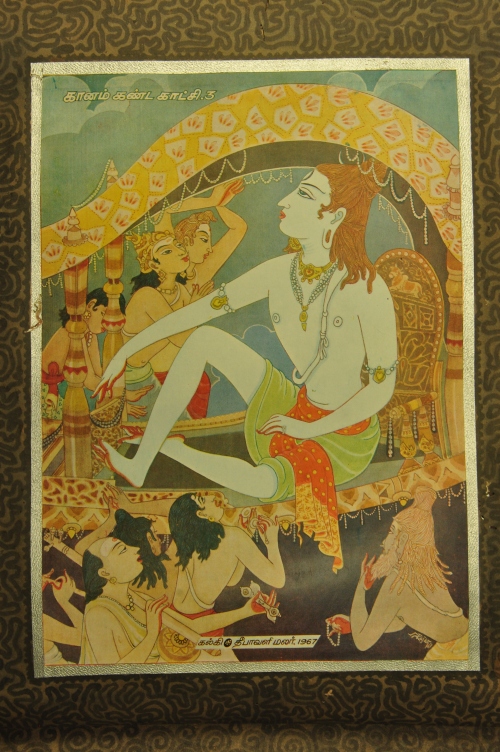
Inspired by the painting posted earlier, I’m posting a recording of the song depicted in the painting. This is from a concert in Montreal in early eighties. Recording Courtesy: Yessel Narasimhan.
Rajam100 – 26 to 28 of 365
Posted in எஸ்.ராஜம், ஓவியர், ராஜம், Rajam100, S.Rajam, tagged Rajam100, Rajam365 on மார்ச் 9, 2019| Leave a Comment »
My apologies for not posting it everyday, although I have been posting it in FB everyday.
Rajam100 – 26 of 365
Here is another cover from Vanoli, depicting the Sangita Pitamaha Purandaradasa.

Rajam100 – Song 26 of 365
Rajam’s greatest passion was to learn kritis from various sources. He had the opportunity of learning songs from very authentic sources (Ambi Dikshitar, Gowri Ammal, Madras Lalithangi) and in some cases from the composer himself (Muthiah Bhagavathar, Papanasam Sivan). He stayed true to his patantharam in his renditions but never disrespected other sources and variations. He was critical if a rendition was totally against the idea of the composer (e.g. Nagumomu in Abheri) but in general was not critical of improvising or embellishment with new sangatis.
He was meticulous in knowing the meaning and the intent of the composer. Compositions that often suffer from butchering can be found rendered with appropriate splitting of the words (Example Manasuloni Marmamulu). His repertoire of the compositions of the trinity was enormous. But what was amazing was his penchant to learn compositions of his contemporaries and his juniors. Once, when I visited him, he was winding up a class for his student Akshay Padmanabhan. After the student left, he spoke with pride for over ten minutes about the tillana Akshay had composed. he would often remark, “AIR might not have given me a lot of money. But it gave me immense satisfaction to learn and propogate rare songs. The famous Purandara Dasa song “Srikanta Enakishtu” is usually sung in raga Kanada. However, a young girl from Mysore had come for a recital and had sung it in raga Kannada. I learnt from her and rendered in my concerts as well. It was only AIR that gave me such opportunities.”
For a long time, I couldn’t find this recording. I found it recently on Facebook through Mr. Subramanian Krishnan. I thank him for sharing this rendition.
Rajam100 – 27 of 365
Another work from 40’s inspired by Bharathi’s verses.

Rajam100 – Song 27 of 365
Today we present a full fledged RTP in Gowrimanohari from an AIR concert.
Rajam100 – 28 of 365
Here is another rare painting from 1939, when he was still a student.
For a long time, I couldn’t locate where this painting was published. A Few days back, Thank to Mr. Aravind Swaminathan, I came to know that this was published in the “Hanuman”.

Rajam100 – Song 28 of 365 – AtukaradhA – Manoranjani
Another recording illustrating why Rajam was considered a genius when it come to handling Vivadhi Ragas.
Rajam100 – 21 to 25 for 365 – Panchalinga Kritis
Posted in அளுமை, ராஜம், Rajam100, tagged Panchalingam, Rajam100, Rajam365 on மார்ச் 9, 2019| Leave a Comment »
Here I present Rajam’s depiction of Panchalinga Kritis along with his unplugged versions.
Akasha Lingam
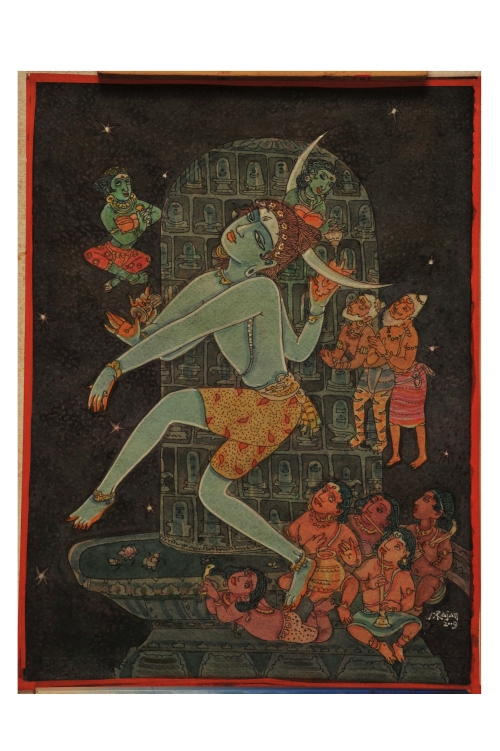
Tejo Lingam
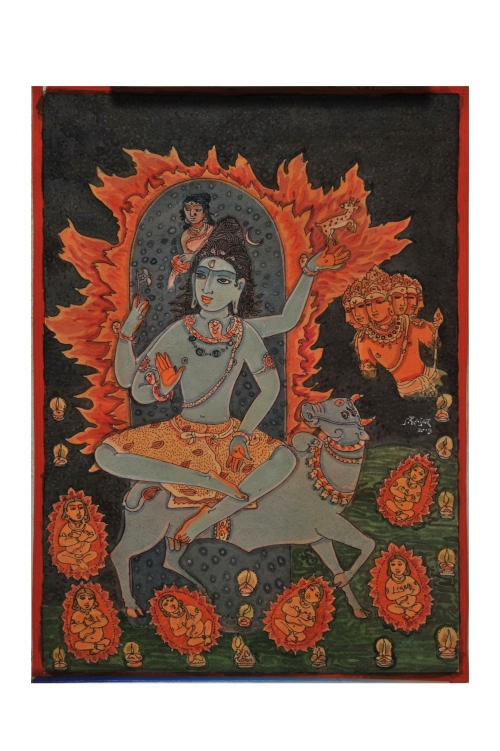
Prithvi Lingam
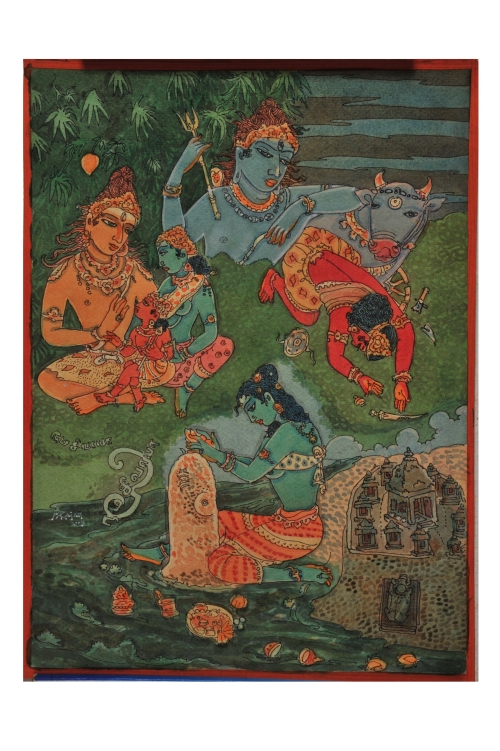
Vayu Lingham

Jambu Lingham

Rajam100 – 18 of 365
Posted in அளுமை, எஸ்.ராஜம், ராஜம், Rajam100, S.Rajam, tagged Amruthavarshini, Rajam100, Rajam365, Shakunthalam on பிப்ரவரி 28, 2019| Leave a Comment »
The picture obviously needs nno explanation. It is from Muthuswami Dikshitar’s life, when he sang Anandamruthakarshini and brought rains.
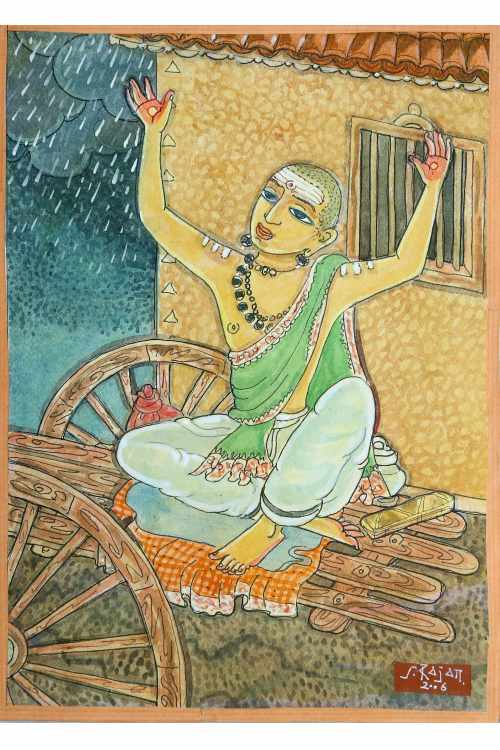
******************************************************************
Rajam100 – Song 18 of 365
Except for a couple of compositions, it is rare to find compositions of Tirupathi Narayanaswami rendered in a concert. Here is a rare song in Shakunthalam – a rare raga and a janya of Harikambhodhi.
Rajam100 – 17 of 365
Posted in அளுமை, எஸ்.ராஜம், ஓவியர், ராஜம், Rajam100, S.Rajam, tagged Rajam100, Rajam365, Yagapriya on பிப்ரவரி 27, 2019| Leave a Comment »
Rajam’s depiction of the carnatic music trinity is extremely popular. Here is a different take on them!

*********************************************************
Rajam100 – Song 17 of 365
Another underappreciated facet of Rajam were his tuning for compositions. Raam had been a part of several programs at the AIR and that provided him an opportunity to tune several songs. He had meticulously maintained two notebooks archiving the programs that were conducted by him. They contained over 600 songs. Most of them were tunes by him and in rare ragas. The most popular song tuned by him is in raga madhuvanti – Sarvam Brahma Mayam.
Here is a composition from the same series in raga Yagapriya
Rajam100 – 16 of 365
Posted in அளுமை, எஸ்.ராஜம், ராஜம், Rajam100, Tribute, tagged Rajam100, Rajam365 on பிப்ரவரி 26, 2019| Leave a Comment »
This was an advertisement for 1956 Deepavali Special Issue. At first glance, a simple line drawing, actually has several layers of details on the lifestyle and the festival.

****************************************************************
A rare composition of Maha Vaidyanatha Sivan in Vachaspati.
Rajam had himself said that GNB and Madurai Mani influenced him a lot. One would think that the GNB influence would be in raga alapana and the MMI influence would be in swara singing. Interestingly, in Rajam’s case, the exploration through shoprt phrases, focusing onthe swara sudhdha and the kaarvais are elements that are found in MMI’s alapana, where as the vocalisation, crisp sangatis and sarvalaghu swaras of Rajam are more reminiscent of GNB style.
Rajam100 – 15 of 365
Posted in அளுமை, ஆவணம், எஸ்.ராஜம், ஓவியர், ராஜம், Rajam100, S.Rajam, Tribute, tagged Rajam100, Rajam365, Rudrakopa, Rudrapriya on பிப்ரவரி 25, 2019| 1 Comment »
Although the print quality and the scan resolution are not great, I post this as this is one of my favorites.
I love the blank canvas and the multiple images running through the mind of the painter during conceptualization in the background.
Published in late fifties in Kalaimagal.

***********************************************************************
This was part of a lecture concert on Dikshitar kritis. An effortless rendition interspersed with crisp insights makes it a valuable recording especially for students. Even in his last days, Rajam sir would talk about Naina Pillai’s rendition of this raga.
Rajam100 – 14 of 365
Posted in அளுமை, எஸ்.ராஜம், ஓவியர், ராஜம், Rajam100, S.Rajam, tagged Rajam100, Rajam365, Sarasangi on பிப்ரவரி 24, 2019| Leave a Comment »
In his formative years, Rajam visited the frescoes in temples such as Kailasanatha Temple, Panaimalai, Sigiriya etc. In some places, he even tried to copy and recreate a portion of it.
Today we present one such attempt of Rajam from 1944. This is part of the Sundarar Panel in Thajavur Brahadeeshwara Temple.
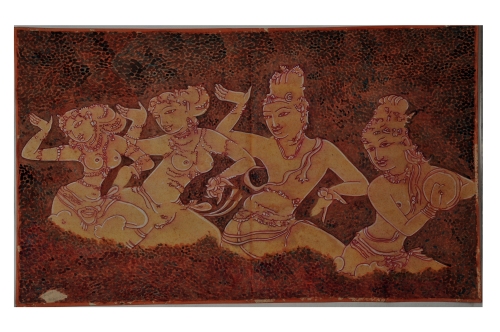
******************************************************************************
Rajam100 – Song 14 of 365
Another Kotiswara Iyer classic that was brought into the concert circle by S.Rajam. His raga development through short yet beatifully connected phrases, clean sangatis and crisp neraval/swaram makes it a delightful listen despite recording glitches.

